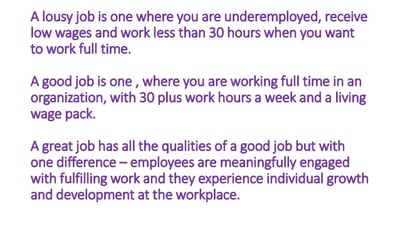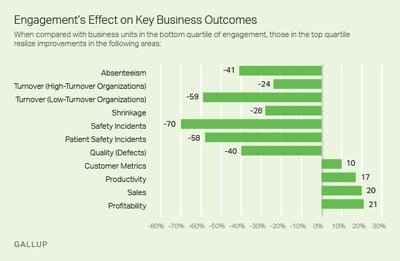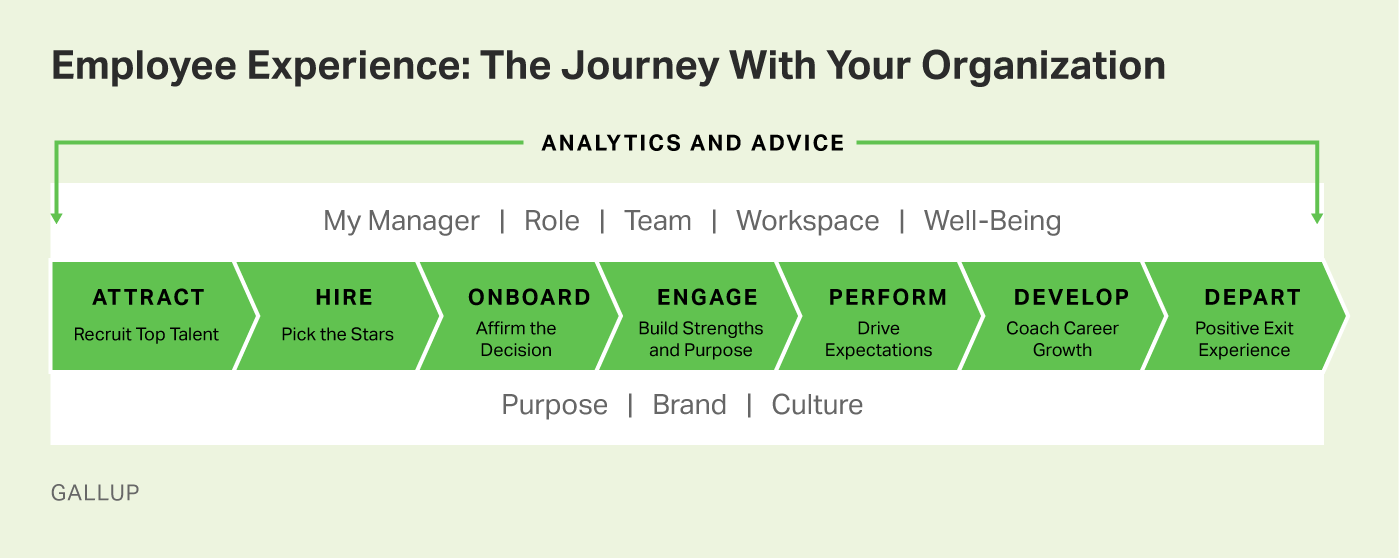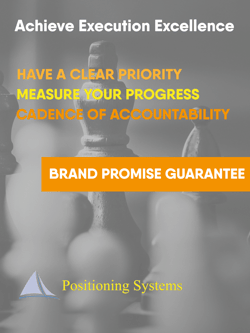.jpg?width=300&name=Changing%20Demands%20in%20the%20Workplace%20(Gallup%20Its%20the%20Manager).jpg) The job environment is changing
The job environment is changing
Today’s worker cares less about job satisfaction and more about personal growth.
It’s just one of several changing demands taking place in your workplace.
These changing demands affect employee engagement and make the difference between your people feeling they’re in a good or great job, or possibly a lousy job.
People are looking for more than just a paycheck. They want purpose and meaning from their work. They want to be known for what makes them unique. And they want relationships, particularly with a manager who can coach them to the next level.
Gallup’s new book, It’s the Manager, shares six changing workplace demands.
Fewer than half of U.S. workers have "good" jobs, according to a Gallup study that rated "good," "mediocre" and "bad" jobs based on 10 dimensions that included pay, benefits, job security and sense of purpose.
Discover more at Not Just a Job: New Evidence on the Quality of Work in the United States
10 Dimensions of Job Quality
Gallup's findings were based on responses from a random sample of 6,644 working adults in the U.S. The research company asked them to rate the importance of 10 dimensions of job quality:
- Level of pay.
- Stable and predictable pay.
- Stable and predictable hours.
- Control over hours and/or job location.
- Job security.
- Employee benefits.
- Career advancement opportunities.
- Enjoying the day-to-day work.
- Having a sense of purpose and dignity at work.
- Having the power to change things that are unsatisfying at work.
In its 2019 Compensation Best Practices Report, the compensation software and data company PayScale found employee appreciation is the most critical component of a worker's sense of engagement and satisfaction with an employer.
 According to Gallup, the current economic expansion is now the longest in U.S. history, yet not all Americans feel the benefits. Wage stagnation and shifting labor market needs have many U.S. workers stuck in low-paying jobs. And labor force participation, even among prime-age adults, is below levels achieved decades ago.
According to Gallup, the current economic expansion is now the longest in U.S. history, yet not all Americans feel the benefits. Wage stagnation and shifting labor market needs have many U.S. workers stuck in low-paying jobs. And labor force participation, even among prime-age adults, is below levels achieved decades ago.
Since 1980, economic gains have increasingly gone to the wealthiest 10% — and even 1% — of income earners.
Overall, 40 percent of respondents to a Gallup survey were in good jobs, while 44 percent were in mediocre jobs, and 16 percent were in bad jobs. What’s the Difference Between a ‘Good’ Job and a ‘Bad’ Job?
KEY FINDINGS FROM THE STUDY
- Less than half of U.S. workers are in good jobs.
- Income inequality translates into inequality in job quality across every dimension.
- Workers at all income levels generally agree on the job quality dimensions most important to them. Enjoying one’s work and having a sense of purpose are broadly prioritized; few workers want their employment situation to be “just a job.”
- Race, ethnicity and gender are strongly correlated with job quality.
- Most workers say their level of pay has improved in recent years, but that other dimensions of job quality have not.
- Workers are more likely to have good jobs if they work for larger organizations and are in roles that allow them to be creative, learn new skills and do their best work.
- Workers in low-quality jobs are less likely to be satisfied and more likely to be actively looking for another job.
Connecting Employee Engagement and the Employee Experience
An organization’s employee experience reflects the entire journey an employee takes with the organization. It includes pre-hire experiences to post-exit interactions, as well as aspects of a job related to an employee’s role, workspace, wellbeing, and relationships with their manager and team.
Gallup defines the employee life cycle with seven stages that capture the most significant employee-employer interactions that connect employees with the organization. The engage, perform and develop stages are interwoven, encompassing primarily the day-to-day interactions of employees.
Employees who receive daily feedback from their manager are three times more likely to be engaged than those who receive feedback once a year or less.
Gallup’s ideas on how to connect employees to a better employee experience, and how my customers are improving theirs is the subject of our next blog.
Growth demands Strategic Discipline.
 To build an enduring great organization, requires disciplined people, disciplined thought, disciplined action, to produce superior results, and make a distinctive impact in the world.
To build an enduring great organization, requires disciplined people, disciplined thought, disciplined action, to produce superior results, and make a distinctive impact in the world.
Discipline sustains momentum, over a long period of time, laying the foundations for lasting endurance.
A winning habit starts with 3 Strategic Disciplines: Priority, Metrics and Meeting Rhythms. Forecasting, accountability, individual, and team performance improve dramatically.
Meeting Rhythms achieve a disciplined focus on performance metrics to drive growth.
Let Positioning Systems help your business achieve these outcomes on the Four most Important Decisions your business faces:
|
DECISION |
RESULT/OUTCOME |
|
PEOPLE |
|
|
STRATEGY |
|
|
EXECUTION |
|
|
CASH |
|
Positioning Systems helps mid-sized ($5M - $250M) business Scale-UP. We align your business to focus on Your One Thing! Contact dwick@positioningsystems.com to Scale Up your business! Take our Four Decisions Needs Assessment to discover how your business measures against other Scaled Up companies. We’ll contact you.
NEXT BLOG – Raise the Bar.jpg?width=300&name=Boss%20to%20A%20Coach%20(Gallup%20Its%20the%20Manager).jpg)
Most employee engagement efforts fail to work. Several of my customers are working on and developing measures to increase employee engagement. Ideas from my customers, Gallup, and Marcus Buckingham to improve employee engagement, next blog.






.jpeg?width=150&height=135&name=Hand%20with%20marker%20writing%20the%20question%20Whats%20Next_%20(1).jpeg)

